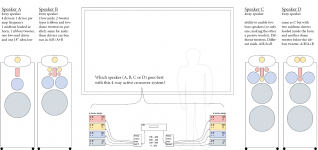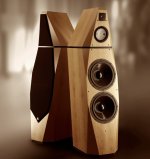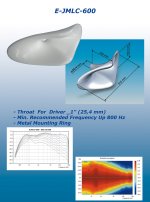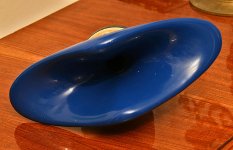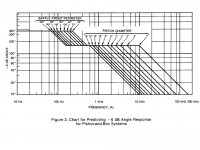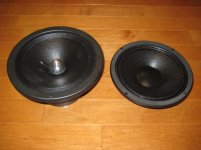Hi folks, this is my first post here! I have made a graphical representation of my audio system (cd player > two 4-way active crossovers driving eight DENON mono amplifiers. Each of the amplifiers has dual speaker output and volume knob). The system is in place. the speakers are not. I am hesitating which of the variations (A, B, C or D) would give me the most flecxibility without too much unnescessary costs/drivers. On the top custom made horn midtones, right below that are Fountek ribbon tweeters. The lowest woofers will be 18" (46cm) woofers. Which speaker (A,B,C or D) would you choose if you advise me to build? Thanks for your suggestions!
An externally hosted image should be here but it was not working when we last tested it.
Attachments
Hi Eftegarie,
I think you will get more expert help if you fully describe your goals and desired specs for your new speakers.
Grade your goals and what you MUST achieve. XX efficiency? 20-20Khz wide BW? horn midrange? ribbon tweeter?
What commercial speakers generate music magic to your ears?
Personally, I only build 3-way speakers, but I would only consider your Speaker A 4-driver design.
The fact that you discuss a horn midrange and show a rectangular Fountek ribbon shape similar to the CD Neo 2 which has a 98 db/watt spec seems to imply that high'ish efficiency is important to you. Even a 98db/watt 18" woofer with baffle step compensation drops to 94-95 db/watt, and this might set the efficiency baseline.
For Speaker A, the horn midrange is the place to start. What is the horn's directivity? Efficiency? Physical Size. I suspect that almost any horn midrange would be large enogh to create lobing with a high crossover frequency ribbon tweeter from the large M-T spacing and differences in directivity. Normally a horn midrange's directivity is matched to a tweeter having a horn of similar dispersion. A 90 x 40 horn is often used for large rooms. A 60 x 60 horn would have pattern control benefits in a small room. The Beyma TPL 150 includes a horn option and allows a 1Khz xover, but it is expensive.
A 89 db/watt efficiency would be easier to build as a T-M-MB-W, similar to your Picture A. No horns. Dispersion could be well controlled from 20Hz up to 10Khz, where even a 19mm dome starts to beam.
1) 19 mm dome tweeter like Vifa XT19TD00-04 89 db/watt
2) 3.5" upper midrange like 10F/4424G00 90 db/watt
Here, the M-T spacing starts to get small enough to reduce lobing. Quarter wavelength is ideal. Half wavelength is the recommended maximum M-T spacing. (1.8hz = 7.5.", so 1/2 lambda = 3.8" M-T spacing)
3) 8" or 10" midbass with 92db/watt
4) 18" woofer with baffle step compensation 94 db/watt
Charles Hansen is the genius behind Avalon speakers and Ayre amps. His top Isis speaker is a 3-way. Dome + 7" midbass + two 13" woofers. A 94db/watt similar DIY speaker design is possible.
I think you will get more expert help if you fully describe your goals and desired specs for your new speakers.
Grade your goals and what you MUST achieve. XX efficiency? 20-20Khz wide BW? horn midrange? ribbon tweeter?
What commercial speakers generate music magic to your ears?
Personally, I only build 3-way speakers, but I would only consider your Speaker A 4-driver design.
The fact that you discuss a horn midrange and show a rectangular Fountek ribbon shape similar to the CD Neo 2 which has a 98 db/watt spec seems to imply that high'ish efficiency is important to you. Even a 98db/watt 18" woofer with baffle step compensation drops to 94-95 db/watt, and this might set the efficiency baseline.
For Speaker A, the horn midrange is the place to start. What is the horn's directivity? Efficiency? Physical Size. I suspect that almost any horn midrange would be large enogh to create lobing with a high crossover frequency ribbon tweeter from the large M-T spacing and differences in directivity. Normally a horn midrange's directivity is matched to a tweeter having a horn of similar dispersion. A 90 x 40 horn is often used for large rooms. A 60 x 60 horn would have pattern control benefits in a small room. The Beyma TPL 150 includes a horn option and allows a 1Khz xover, but it is expensive.
A 89 db/watt efficiency would be easier to build as a T-M-MB-W, similar to your Picture A. No horns. Dispersion could be well controlled from 20Hz up to 10Khz, where even a 19mm dome starts to beam.
1) 19 mm dome tweeter like Vifa XT19TD00-04 89 db/watt
2) 3.5" upper midrange like 10F/4424G00 90 db/watt
Here, the M-T spacing starts to get small enough to reduce lobing. Quarter wavelength is ideal. Half wavelength is the recommended maximum M-T spacing. (1.8hz = 7.5.", so 1/2 lambda = 3.8" M-T spacing)
3) 8" or 10" midbass with 92db/watt
4) 18" woofer with baffle step compensation 94 db/watt
Charles Hansen is the genius behind Avalon speakers and Ayre amps. His top Isis speaker is a 3-way. Dome + 7" midbass + two 13" woofers. A 94db/watt similar DIY speaker design is possible.
Attachments
+1. The problem is choosing the drivers (right), 3/4-Way. That will make a great design.I would not be one to discourage but "Diminishing returns" comes to mind.
P
Hi Eftegarie,
If an oval horn is an important element of your next speaker, the eliptical LeCleach discussed in the forum would be a good tweeter choice. This "big lips" horn comes in several colors.
The E-JMLC-600 is a 21" wide oval horn that has a 90 degree dispersion when crossed at 1,000Hz. Several 1" compression drivers approach 20Khz extension and avoid the difficult marriage of either a ribbon super tweeter or a Fostek type super tweeter mini-horn.
A high efficiency 10" midbass starts to approach 90 degree dispersion around 1,000Hz, and this helps provide a more seamless controlled dispersion for the listeners. An efficienct wide BW 18" woofer crossed at 100Hz would complete this 3-way.
I believe most experts would give this 3-way high marks.
If an oval horn is an important element of your next speaker, the eliptical LeCleach discussed in the forum would be a good tweeter choice. This "big lips" horn comes in several colors.
The E-JMLC-600 is a 21" wide oval horn that has a 90 degree dispersion when crossed at 1,000Hz. Several 1" compression drivers approach 20Khz extension and avoid the difficult marriage of either a ribbon super tweeter or a Fostek type super tweeter mini-horn.
A high efficiency 10" midbass starts to approach 90 degree dispersion around 1,000Hz, and this helps provide a more seamless controlled dispersion for the listeners. An efficienct wide BW 18" woofer crossed at 100Hz would complete this 3-way.
I believe most experts would give this 3-way high marks.
Attachments
Reminds me of my days as a teenager doodling representations of walls of speakers, thinking that as long as there was room on the page for more, things could only get better. I've since learned that this is not the case.
Do some research on lobing, combing, phase alignment, and controlled directivity. After reading around a bit, come back and let us know if you are still interested in multiple mids side by side and multiple tweeters scattered all over the place.
A good place to start is line array theory. Though most of the publications are directed at large scale sound reinforcement (so you can ignore the issues about time correction in those articles because you're not building a 60foot high wall of speakers here), they do a good job of pointing out the effects of the classic "grouping" and "smattering" of drivers all over the place. Years ago, it was all they knew how to do. You can take what they have learned over the years, and apply it in your living room. What you'll learn, is that, in your living room, less is actually "more" in most cases.
Do some research on lobing, combing, phase alignment, and controlled directivity. After reading around a bit, come back and let us know if you are still interested in multiple mids side by side and multiple tweeters scattered all over the place.
A good place to start is line array theory. Though most of the publications are directed at large scale sound reinforcement (so you can ignore the issues about time correction in those articles because you're not building a 60foot high wall of speakers here), they do a good job of pointing out the effects of the classic "grouping" and "smattering" of drivers all over the place. Years ago, it was all they knew how to do. You can take what they have learned over the years, and apply it in your living room. What you'll learn, is that, in your living room, less is actually "more" in most cases.
Reminds me of my days as a teenager doodling representations of walls of speakers, thinking that as long as there was room on the page for more, things could only get better. I've since learned that this is not the case.
Do some research on lobing, combing, phase alignment, and controlled directivity. After reading around a bit, come back and let us know if you are still interested in multiple mids side by side and multiple tweeters scattered all over the place.
A good place to start is line array theory. Though most of the publications are directed at large scale sound reinforcement (so you can ignore the issues about time correction in those articles because you're not building a 60foot high wall of speakers here), they do a good job of pointing out the effects of the classic "grouping" and "smattering" of drivers all over the place. Years ago, it was all they knew how to do. You can take what they have learned over the years, and apply it in your living room. What you'll learn, is that, in your living room, less is actually "more" in most cases.
+++
Alternatives include your living room's being 2000+ sq ft (and it would be good if the room were designed with proportion and damping in mind.)
That said, my "daddy likes" speakers are 5-way. If you are in the neighborhood, I need help moving them back to their domain. They are designed to be at least 11 ft apart and no closer than 3 ft from side and back walls.
I thought I could tame their current location. wrong. i was
Right now, I think the bang for the money is in 2.5 ways.
P
- Status
- This old topic is closed. If you want to reopen this topic, contact a moderator using the "Report Post" button.
- Home
- Loudspeakers
- Multi-Way
- 4 versions of a 4 way speaker. Which to choose??
